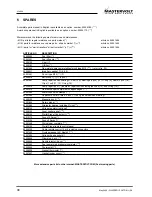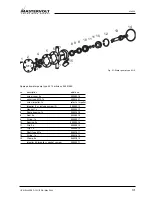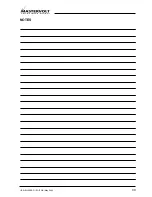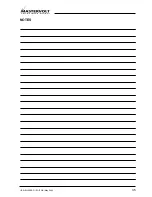
20
May 2004 / WHISPER 15 ULTRA / USA
MAINTENANCE
4 MAINTENANCE
4.1 ALTERNATOR
The alternator does not require any maintenance. Perio-
dic inspection and cleaning is recommended, depending
on environmental conditions.
However when the alternator has been idle for a long
period attention to winding condition is recommended.
The condition of windings can be assessed by measure-
ment of insulation resistance to earth.
The CAPACITOR should be disconnected during this
test. A 500V ‘Megger’ or similar instrument should be
used. The insulation resistance to earth of all windings
should be in excess of 1.0 MOhm. Should the insulation
resistance be less than this value, drying out the genera-
tor windings is essential. Drying out can be carried out by
direct warm air from a fan heater or similar apparatus into
the generator air inlets or outlets.
All bearings are greased for life and not regreasable.
4.2 ENGINE
4.2.1 Preliminary
instructions
All regular maintenance can be executed when the en-
closure is open. When oil and dirt has gathered in the
enclosure measures has to be taken to avoid spilling oil
and polluting the environment.
The first service on the engine should be carried out after
50 hours of its life and after a major overhaul. In the first
50 hours the engine should receive special attention:
Long periods of light or no load running in the first 50
hours may lead to cylinder glazing and high oil consump-
tion.
For the same reason it is of the greatest
importance to use the right oil specifica-
tion.
The first time starting up or after running out of fuel it
could be necessary to prime the fuel system.
4.2.2 Bleeding fuel lines
Ensure there is sufficient fuel. The system is self
bleeding. The first time starting up or after running out of
fuel it could be necessary to prime the fuel system. Push
“start” and monitor the display. When more time is
needed to bleed, push and hold the start button on the
local control panel (so not on remote control). Hold as
long as necessary to bleed the system. Retighten the
bleed screw when no further air bubbles are expelled.
4.2.3 Valve
clearance
When the engine is in cold condition both valves should
have a clearance between 0.25 mm. The adjustment has
to be done at TDC (refer to § 5.4.2).
4.2.4 Replacing fuel filter
Filter change depends on contamination of the fuel, but
should be done however, at least every 300 running
hours. Before changing the filter, clamp off the supply
line. Remove the hoses from filter and attach them on the
new filter again. The arrow on the filter housing indicates
the direction of the flow. A clogged filter results in a lack
of output of the generating set.
4.2.5 Replacing the oil filter
The oil filter is in front of the service side. Replacement
has to be executed according to the schedule in this
manual. Drain the oil using the sump pump and put some
tissues under the filter.
1
2
Fig. 11: Bleeding fuel lines.
1= fuel bleeding screw
Fig. 12.
















































